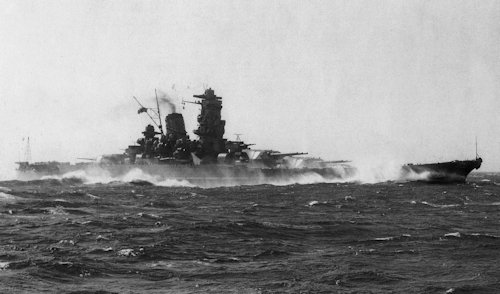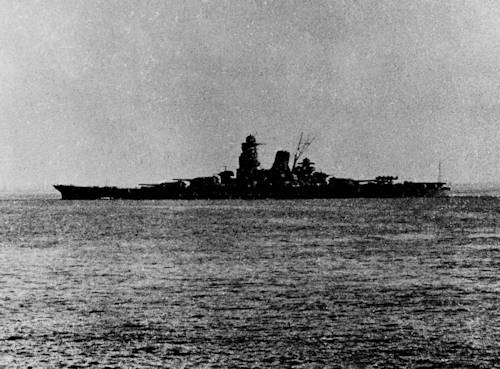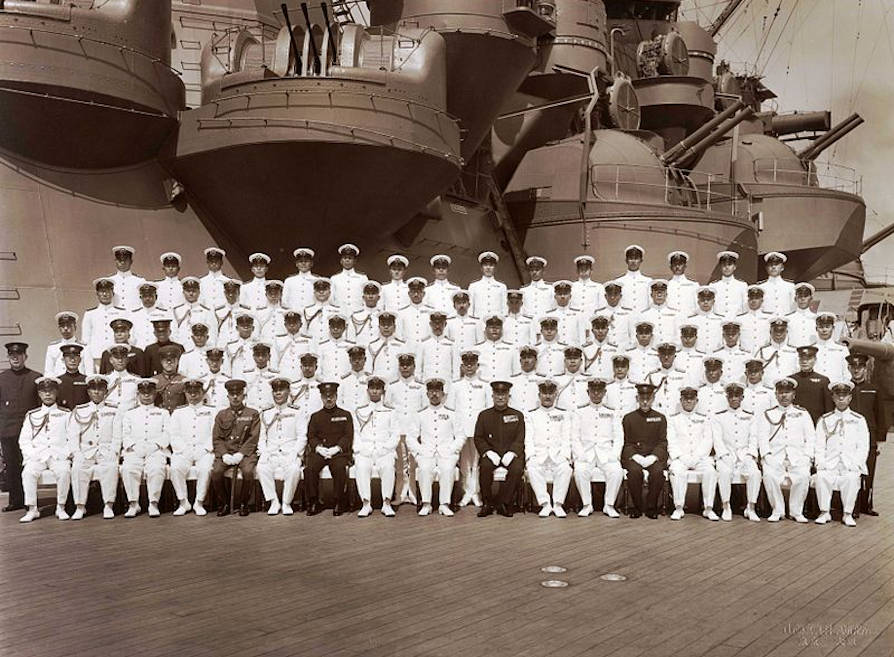The great battleships Yamato e Musashi they were the most famous and demanding constructions of the Japanese Imperial Navy. Ships impressive for their size and for the set of characteristics, but that nevertheless remained the example of warfare uselessness in the modern naval war. The only factor that was put to the test was their robustness and their exceptional protection, which resisted the effects of numerous bombs and torpedoes. But in the end they also reached the bottom of the sea, without having had the opportunity to demonstrate how much they were worth in a battle that modern naval operations would have very unlikely to give them.
The technical heritage that the Imperial Navy's technical bodies had accumulated in the years just ended the first world war, the result of studies and technical exchanges with the western naval powers, allowed the construction of the great battleships of the class Tosa and of the class battle cruisers Amagi. In the first three decades of the last century, when it became clear that the international agreements on arms limitation would not have come to nothing, Japan in the 1934 began designing new battle units free from the limitations imposed by the treaties, several projects were prepared, some complete others only sketched, all based on a main armament with a caliber greater than 406 mm (457 or 460 mm), on speeds ranging between 21 and 35 nodes. Denounced the treaties of Washington and London, the Empire of the Rising Sun carried out the expansion of the fleet. The development of the Yamato it came at the end of a long process of revision of the plans of development of the Japanese Imperial Navy, with a view to adapting its naval units in the context of great economic and commercial power, as already Japan was about to become in those years. The General Staff of the Imperial Navy therefore had to make a choice on the new type of battleship.
Yamato
 In March 1937, after a long experimentation on scale models carried out in the pool of the Center for Technical Naval Research in Tokyo, was drawn up the final project that included a ship from 68.000 tons, long up to 260 meters, with a classic motor apparatus capable of a speed of 26 nodes and with a protection system without equal in the world. There Yamato The 4 November 1937 was set up at the Kure Arsenal on November 8, and 1940 16 went into service on December 1941 (nine days after the attack on Pearl Harbor). It was in the intentions of the Japanese Imperial Navy to build four ships of this class, but in the 1942 it was decided that the Shinano, third unit set in 1940, was transformed into aircraft carrier (this while still on the hull); torpedoed by the American submarine Archerfish, sank in the 1944. The fourth unit was set up in the Kure arsenal, but its construction was interrupted in September of the 1942, when it was about 30% of the work.
In March 1937, after a long experimentation on scale models carried out in the pool of the Center for Technical Naval Research in Tokyo, was drawn up the final project that included a ship from 68.000 tons, long up to 260 meters, with a classic motor apparatus capable of a speed of 26 nodes and with a protection system without equal in the world. There Yamato The 4 November 1937 was set up at the Kure Arsenal on November 8, and 1940 16 went into service on December 1941 (nine days after the attack on Pearl Harbor). It was in the intentions of the Japanese Imperial Navy to build four ships of this class, but in the 1942 it was decided that the Shinano, third unit set in 1940, was transformed into aircraft carrier (this while still on the hull); torpedoed by the American submarine Archerfish, sank in the 1944. The fourth unit was set up in the Kure arsenal, but its construction was interrupted in September of the 1942, when it was about 30% of the work.
The construction of these huge units imposed changes and reinforcement of the structures and equipment of the building sites. Specially for this ship were built floating cranes of the capacity of 150 and 350 tons for heavy lifting and was even built in secret a special transport vessel, or the Kashino, for the transport from the factory to the construction sites of the huge towers and large-caliber artillery to be placed on the battleships. The truncated towers from 457 mm, two in the bow and one in the stern, weighed each 2.510 tons without ammunition. The development of these new cannons was kept secret: officially the armament of this class of ships consisted of pieces from 406 mm, the same caliber expected for the US class Iowa. In the annual budgets of the Japanese Imperial Navy the huge development costs of the new cannons were spread over different voices, so that they could go unnoticed by foreign intelligence services. In the planning phase it was foreseen for the Yamato a mixed engine system, 2 turbo-gear units from 75.000 HP each and 2 groups of double-acting diesel engines from 60.000 HP, a solution that would have allowed a good fuel saving and a longer autonomy. But the disappointing results of diesel engines installed on board the submersible support vessel Taigei, induced the designers to prefer a more traditional type of apparatus on 12 boilers and 4 turbo-reducing groups. The maximum speed of 27 nodes and the power of 150.000 HP, were judged more than sufficient for operational needs. At the tests la Yamato reached the 27,7 nodes with 158.000 HP power. Powerful and modern was the armament in every component. He took part in the battle of the Midway (June 1942), but without being able to get a good distance to be able to hire American aircraft carriers. During the 1943, the Yamato he returned to the Kure shipyard where his anti-aircraft artillery equipment was greatly enhanced. Towards the middle of the 1943 he returned to Truk, along with his sister Musashi, to protect the Marshall Islands and the Gilbert Islands, but never come into contact with the American forces.
 From 12 February 1942 to 11 February 1943, the Yamato was the flagship of Admiral Isoroku Yamamoto (1884-1943), then alternated by the Musashi (in the photo visible both). The 24 December 1943 was severely damaged by a torpedo from the submarine USS Skate and restoration work was only completed in April 1944. Back in active service, he took part in the Battle of the Philippine Sea (19-21 June 1944) and the offshore Samaer, part of the wider Leyte Gulf (23-26 October 1944) generally considered the largest naval battle in second World War; here, for the first time, he made use of his main weaponry, firing 104 hits from 457 mm, and probably hit a destroyer and an aircraft carrier.
From 12 February 1942 to 11 February 1943, the Yamato was the flagship of Admiral Isoroku Yamamoto (1884-1943), then alternated by the Musashi (in the photo visible both). The 24 December 1943 was severely damaged by a torpedo from the submarine USS Skate and restoration work was only completed in April 1944. Back in active service, he took part in the Battle of the Philippine Sea (19-21 June 1944) and the offshore Samaer, part of the wider Leyte Gulf (23-26 October 1944) generally considered the largest naval battle in second World War; here, for the first time, he made use of his main weaponry, firing 104 hits from 457 mm, and probably hit a destroyer and an aircraft carrier.
The last mission ofYamato it was the Operation "Ten-Go" (the last sortie of the Japanese Imperial Navy), organized following the invasion of Okinawa (1 April 1945). The fleet, under the command of Vice-Admiral Seiichi Ito (1890-1945), which included Yamato a light cruiser and eight destroyers, was sent to attack the American fleet that supported the landing in the western part of the island. The aim was to remove the aircraft carriers from Okinawa to facilitate the attack of the kamikaze against the invasion fleet (about 1.500 ships) that supported the landing. If he could reach Okinawa, the Yamato he would have had to go and run aground between Hagushi and Yontan and fight to the end as a coastal battery, in support of the island's defenders. Intended as a suicide mission, the unit was supplied with sufficient fuel for the one-way trip; however, the Tokiuyama fuel depot, bravely, ignored the orders and provided much more fuel to the team. There Yamato and his escort left the port of Tokuyama on the afternoon of 6 April 1945. On the morning of the April 7 the team was spotted at the exit of the Inland Sea of Japan by two US submarines and an aircraft carrier scout Essex. Around midday, a force of nearly 400 American planes from the 58 Task Force, in successive waves, attacked the Japanese units. At 12: 41 la Yamato she was hit by the first two bombs. Overall hit by at least 13 torpedoes and 10 bombs, before the NXXXX ammunition depot exploded towards the 14: 20. The ship leaned on its left side and sank, missing about 1 miles to Okinawa. The sinking was rapid also due to the almost contemporary detachment of the three main towers, unhinged from the bridge by their own enormous weight. In the sinking they lost their lives about 370 men and there were only surviving 2.375s. Of the ships of his escort four were sunk and five, severely damaged, were forced to return to Japan. The American losses were 269 airplanes and 10 pilots. The wreck lies about 12 meters deep and has been explored in the 300 and 1985.
Musashi
 In June 1937 engineers from the Mitsubishi shipyard in Nagasaki received orders to begin preparations for the construction of a battleship. Built under the strictest measures of secrecy, including the erection of large screens to hide the building at the US embassy located opposite the port, the battle ship was set on November 1 1940 and spent nearly eighteen months under construction. The launch date was revised several times to allow the modifications required by the Navy, including a larger armor on the 155 mm turrets and the installation of additional communications systems. Launched the 5 on August 1942, the Musashi he went to the Truk archipelago, where he became the flagship of Admiral Isoroku Yamamoto. After his death, the 18 April 1943, the Musashi he transported his ashes to Japan. He returned the 5 1943 on August 10 and stayed there until 1944 February 29. The 1944 March XNUMX was hit by a torpedo of theUSS Tunny and had to return to Japan for repairs and modifications to his anti-aircraft armament. During the battle of the Gulf of Leyte, together with the Yamato, was part of the central force of Vice Admiral Takeo Kurita (1889-1977). In this battle, the 24 October 1944, was attacked in the sea of Sibuyan by aircraft of American ships: the first contact with enemy planes occurred at 10: 27 when eight SB2C Helldiver bombers, coming fromUSS Intrepid, attacked the ship with bombs from 227 kg. Wave after wave attacks from aircraft carriers USS Intrepid, Essex and Lexingtonships that proved successful in the Pacific War, centered the ship with 17 bombs and 20 torpedoes. There Musashi he tipped over to the port and sank to the 19: 25 of the 24 October, bringing with him more 1.000 than his 2.399 crew members; 1.376 men were rescued by destroyers Kiyoshimo e Shimakaze.
In June 1937 engineers from the Mitsubishi shipyard in Nagasaki received orders to begin preparations for the construction of a battleship. Built under the strictest measures of secrecy, including the erection of large screens to hide the building at the US embassy located opposite the port, the battle ship was set on November 1 1940 and spent nearly eighteen months under construction. The launch date was revised several times to allow the modifications required by the Navy, including a larger armor on the 155 mm turrets and the installation of additional communications systems. Launched the 5 on August 1942, the Musashi he went to the Truk archipelago, where he became the flagship of Admiral Isoroku Yamamoto. After his death, the 18 April 1943, the Musashi he transported his ashes to Japan. He returned the 5 1943 on August 10 and stayed there until 1944 February 29. The 1944 March XNUMX was hit by a torpedo of theUSS Tunny and had to return to Japan for repairs and modifications to his anti-aircraft armament. During the battle of the Gulf of Leyte, together with the Yamato, was part of the central force of Vice Admiral Takeo Kurita (1889-1977). In this battle, the 24 October 1944, was attacked in the sea of Sibuyan by aircraft of American ships: the first contact with enemy planes occurred at 10: 27 when eight SB2C Helldiver bombers, coming fromUSS Intrepid, attacked the ship with bombs from 227 kg. Wave after wave attacks from aircraft carriers USS Intrepid, Essex and Lexingtonships that proved successful in the Pacific War, centered the ship with 17 bombs and 20 torpedoes. There Musashi he tipped over to the port and sank to the 19: 25 of the 24 October, bringing with him more 1.000 than his 2.399 crew members; 1.376 men were rescued by destroyers Kiyoshimo e Shimakaze.
Thus ended, almost without fighting, the history of these great ships, wanted in the perspective of a naval policy that was still based on the principles of the early twentieth century. The Pacific War showed that on large spaces, and without being able to rely on naval bases, the winning weapon was the aircraft carrier and its air force on board.













